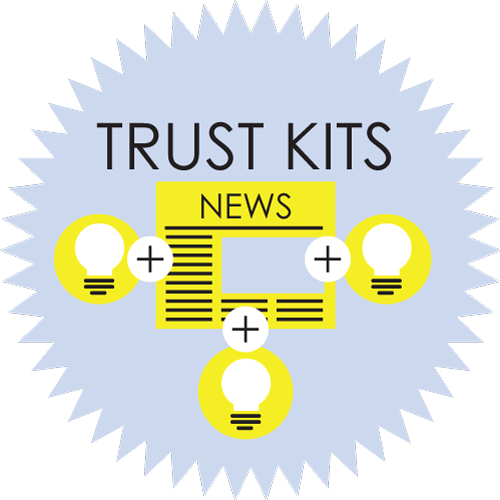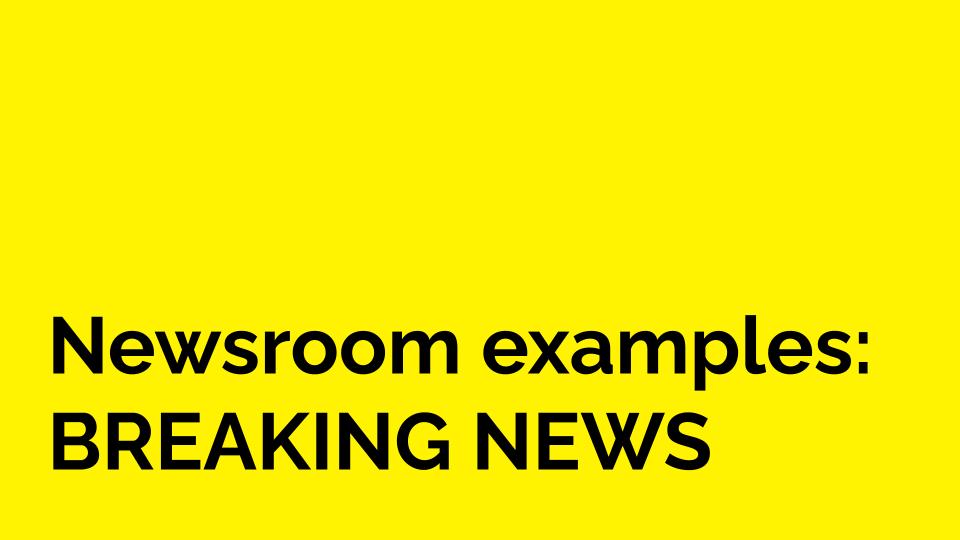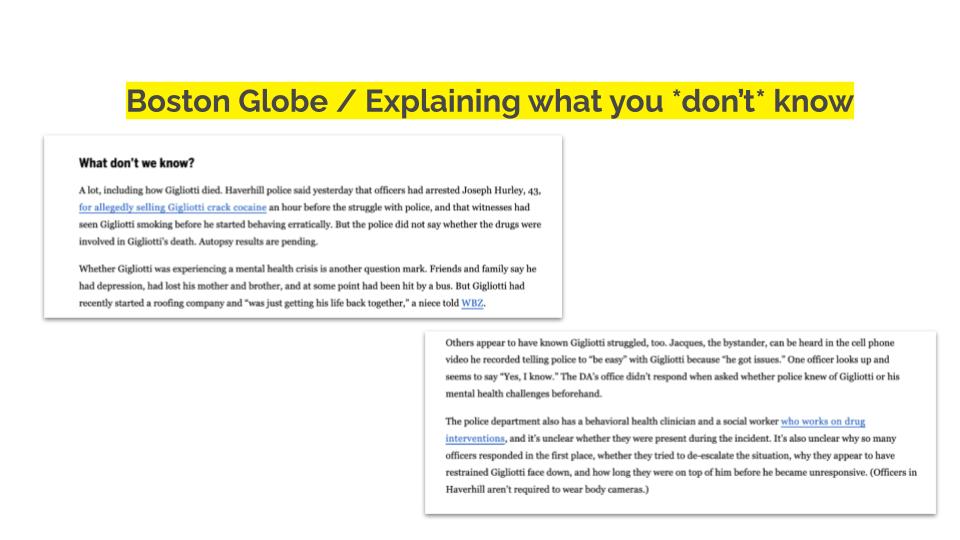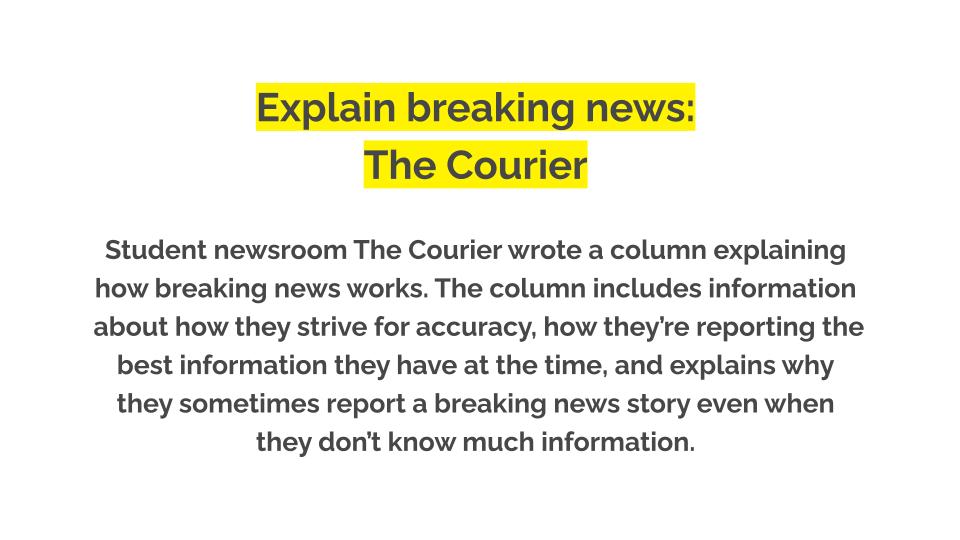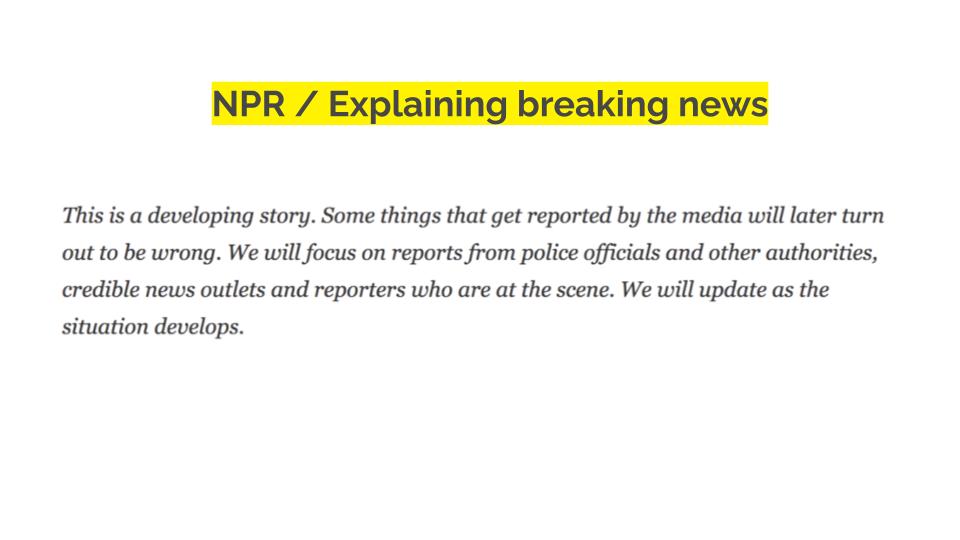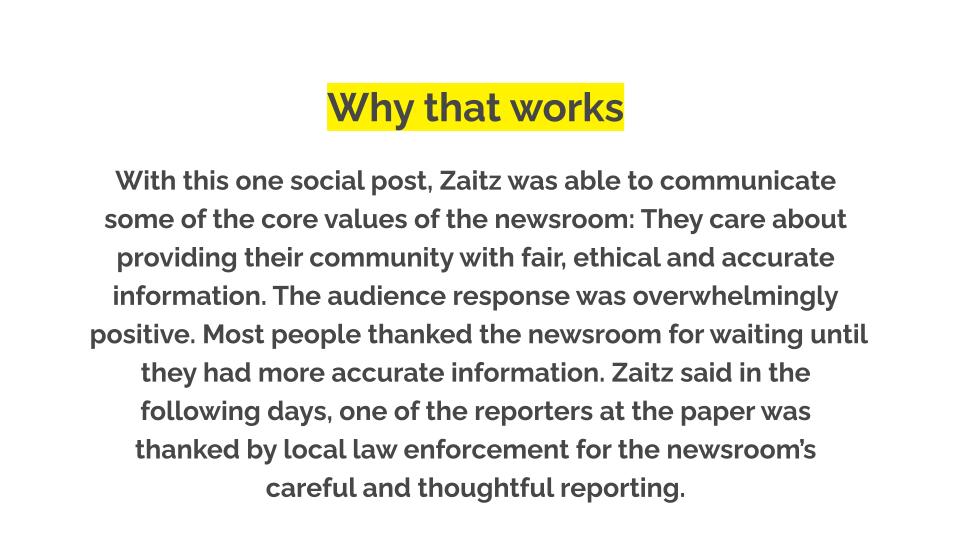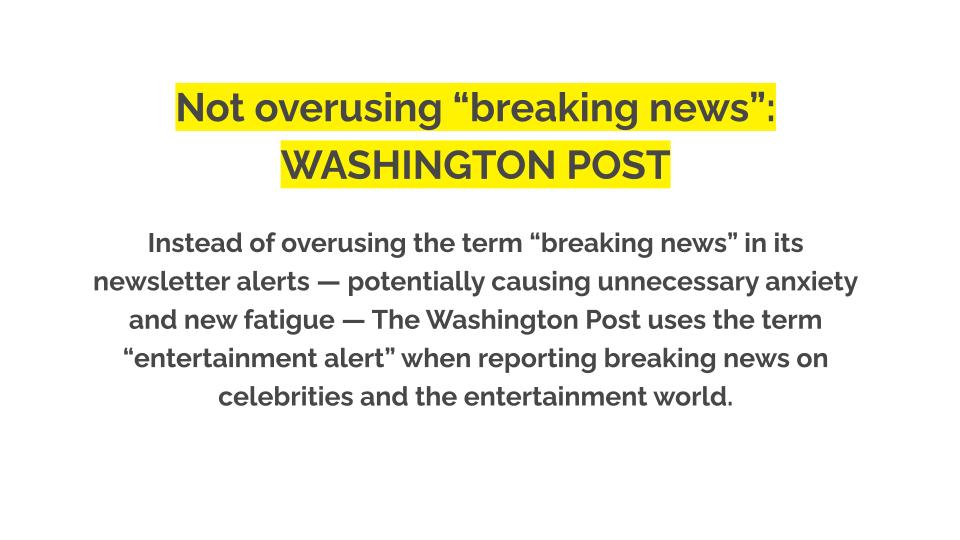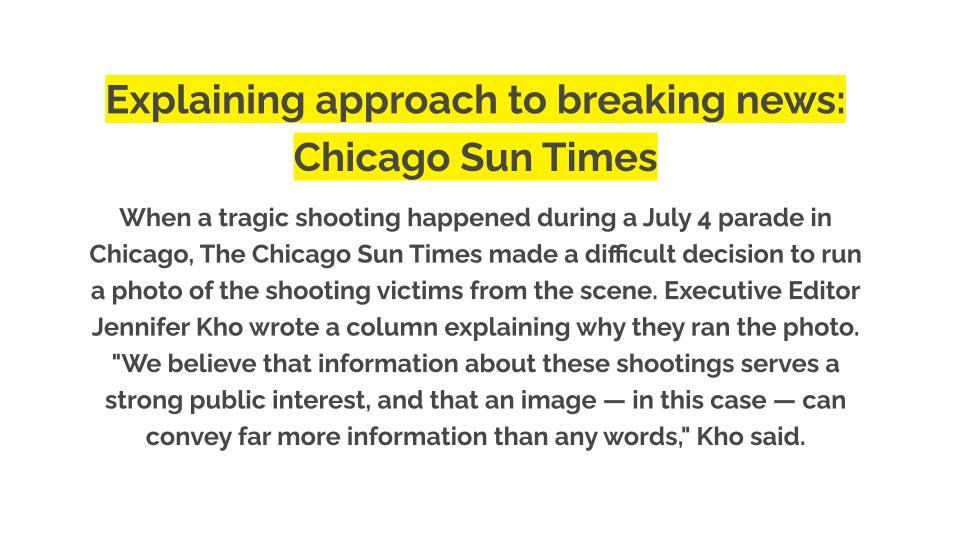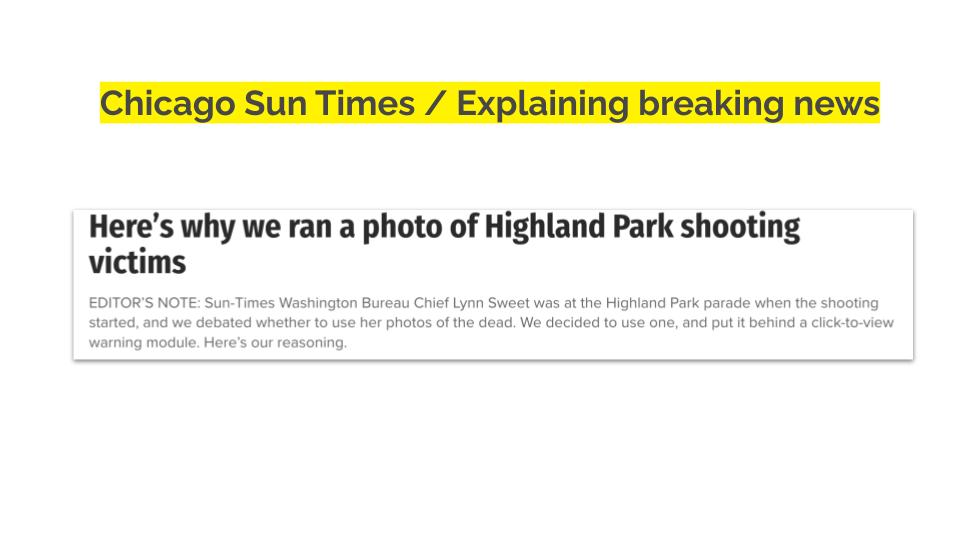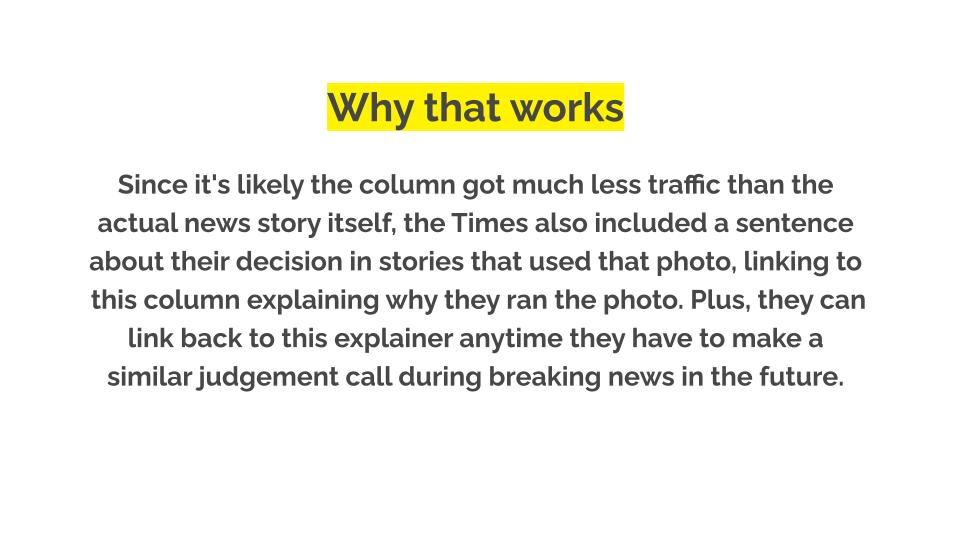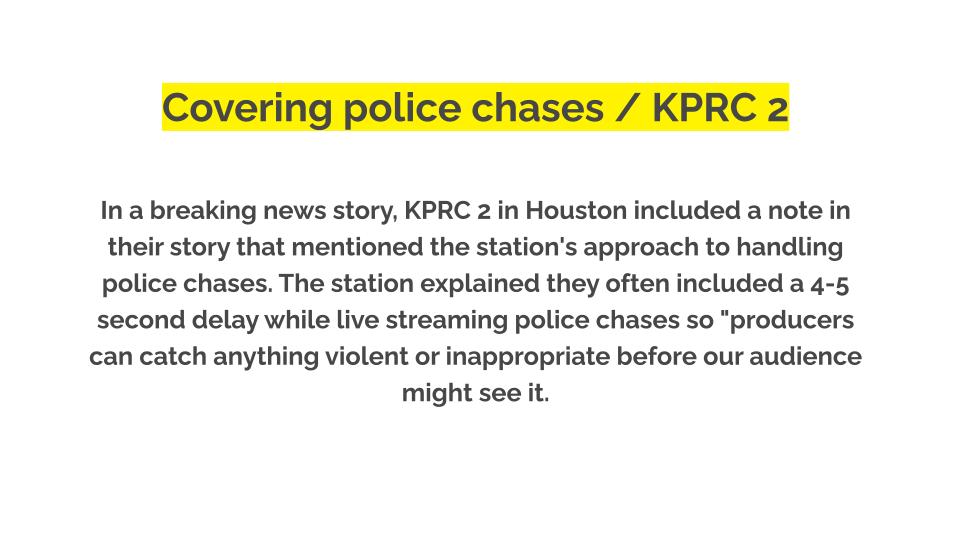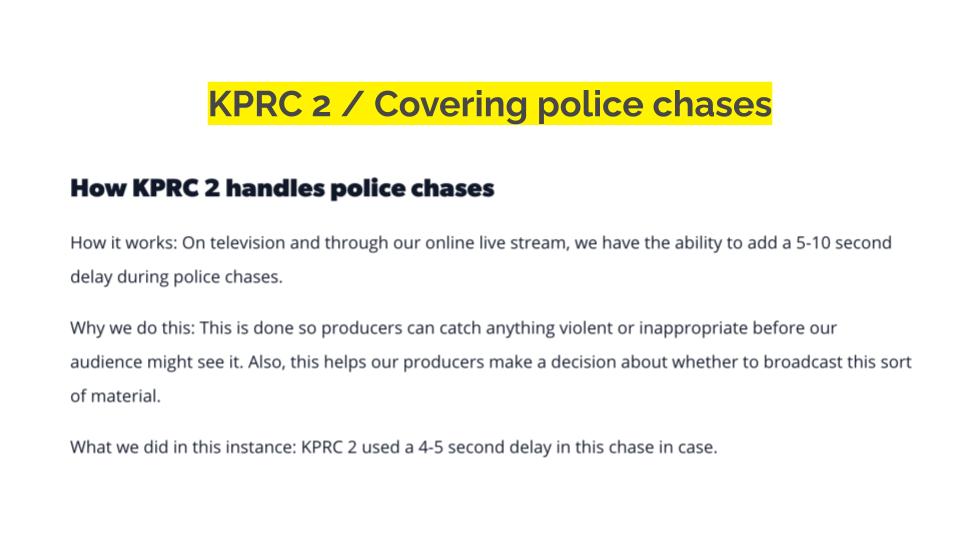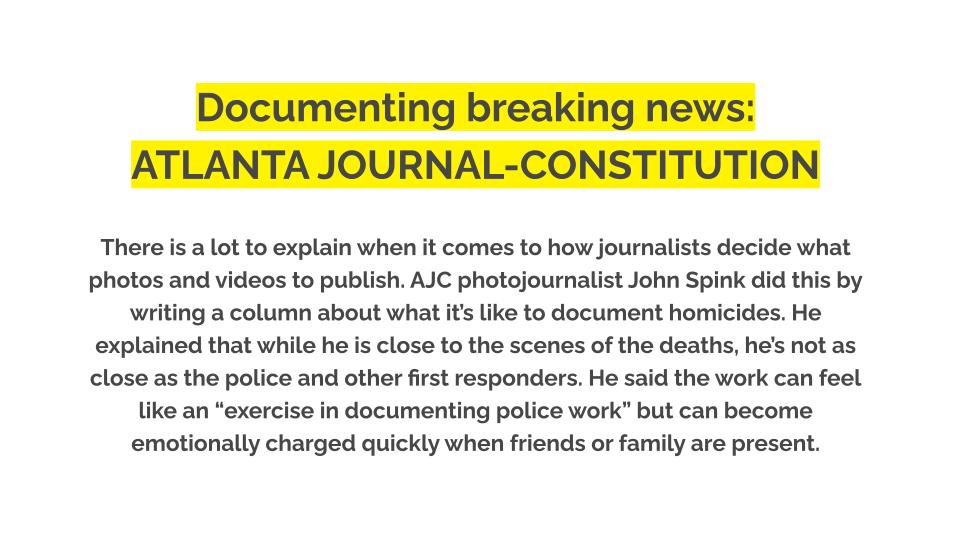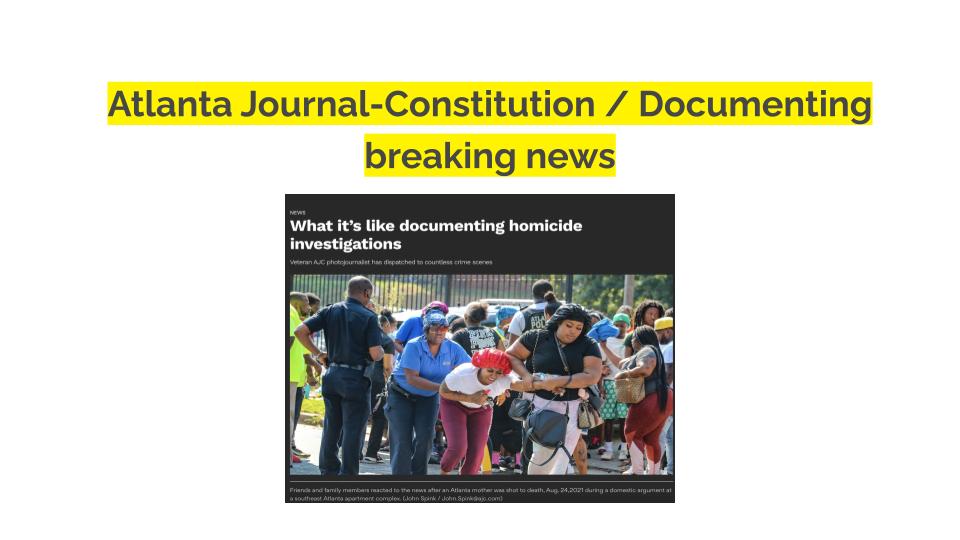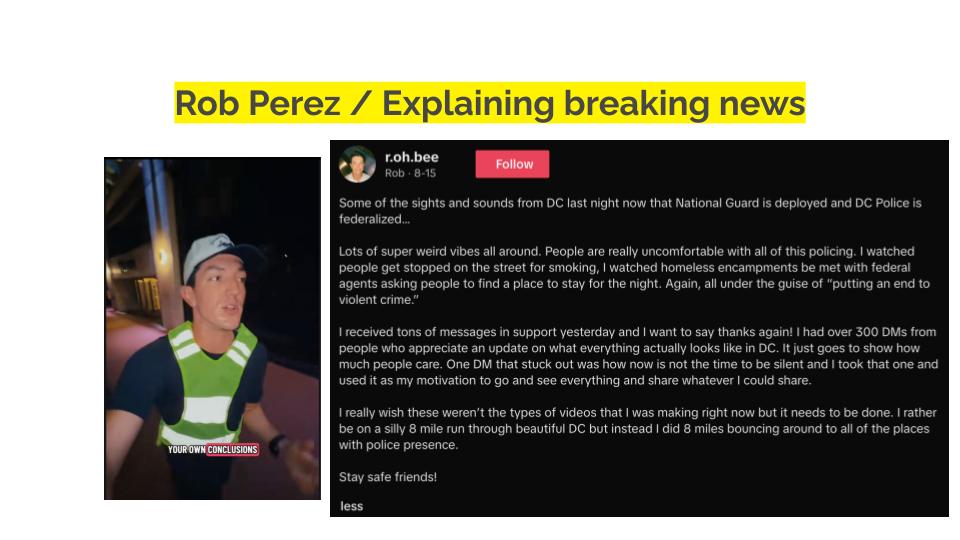HOW NEWS WORKS
Breaking News
When breaking news is actively unfolding, there’s usually heightened attention on news coverage.
Many journalists thrive in these situations, fueled by adrenaline and the opportunity to fulfill the duty of providing helpful, timely information to people.
But breaking news can also be a time when a lot of mistakes happen. Things move quickly, and it’s not uncommon to report something that will later change or need to be corrected.
Plus, as the information landscape continues to fragment, it’s making it increasingly difficult for people to decipher where information is coming from and whether it’s accurate. It’s not hard to imagine how these situations can be confusing for news consumers or may cause them to question just how trustworthy the information they’re seeing really is.
Instead of letting confusion or uncertainty thrive, you have the opportunity to establish yourself as a source of accurate, helpful information.
This Trust Kit will walk you through how.
Breaking news is often a time when mistakes happen. Things move quickly, and it’s not uncommon to report something that will later change or need to be corrected.

Goals
This Trust Kit helps you:
- Explain the decisions behind your news coverage
- Share how you’re working to provide accurate, responsible information
- Establish yourself as a trusted, accurate informer
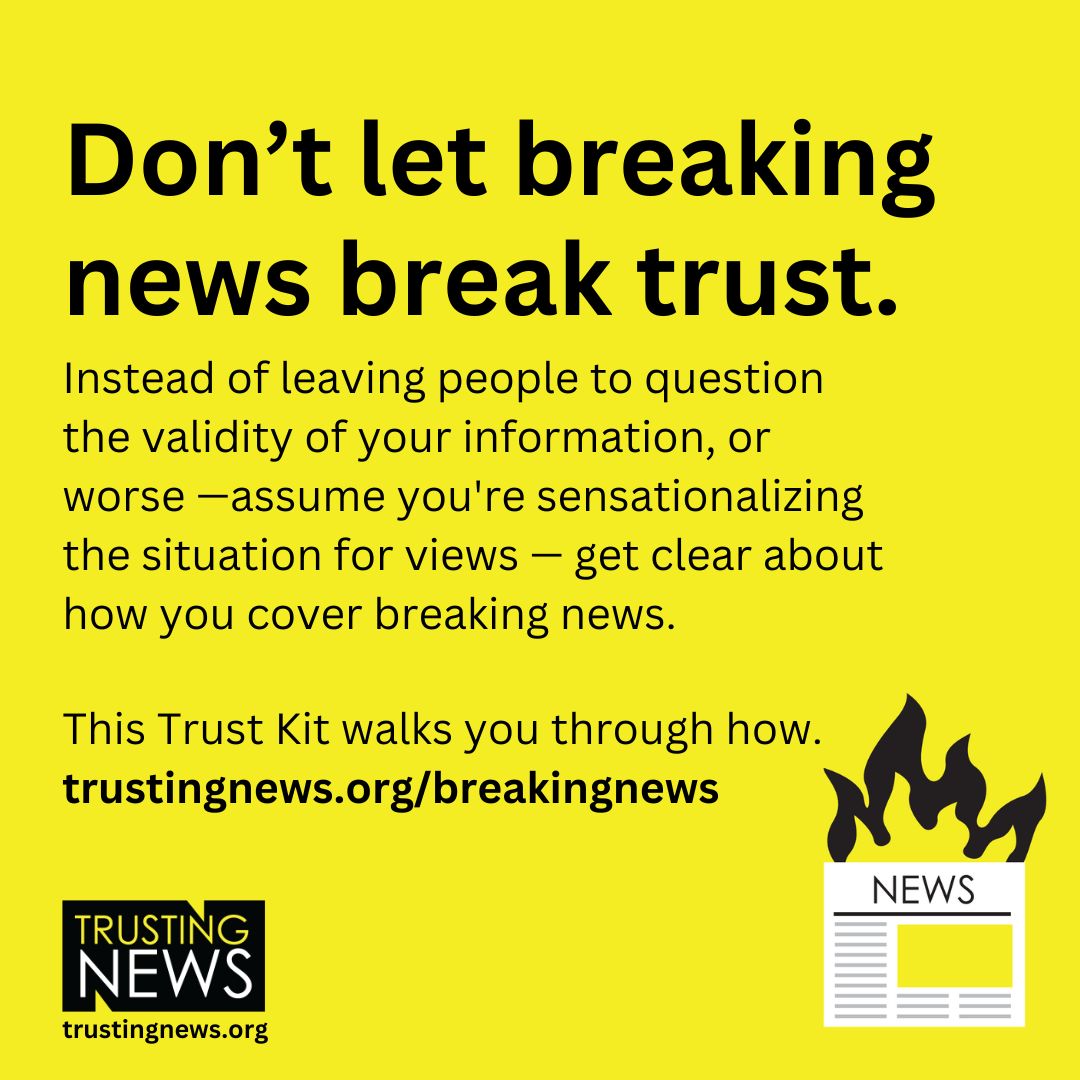

Strategies
Covering breaking news can be hectic, and trying to think about anything else beyond just keeping information updated can seem impossible. But if you’re not sharing your commitment to accuracy and fairness with your audience, will people know you’re a credible source they can rely on?
Instead of leaving people to question the validity of information, or worse, assume you’re trying to sensationalize the situation for views, get on the record about how you cover breaking news.
Below are some ways you can. Many of these explainers are ones you could prepare ahead of item and have ready for when a breaking news situation happens.
Explain that information may change
Things evolve quickly during breaking news situations. The story might be changing every hour, and information — even from official sources — might need to be updated multiple times.
Be upfront with your audience and acknowledge from the get-go that information might change, but you’re committed to directing them to the most accurate information possible. (We love this example from our newsroom partners at WITF, where they say, “we’ll only point to the best information we have at the time.”)
Also, be extremely clear about where information is coming from, whether it is a press release from the police department or from eyewitness accounts. Doing this helps the audience understand our process and what we are doing to prevent mistakes.
And, when information does change or a mistake happens, correct it quickly and note that the information was corrected. Remember, people with low trust in news often don’t believe journalists care very much about accuracy, and they definitely don’t assume errors will be acknowledged. Breaking news is a great time to establish this important facet of your credibility.
For more on how to correct errors, check out our Corrections Trust Kit.
Explain what you *don't* know
As journalists, our job is to know things. So when we don’t have answers, sometimes we simply write around whatever information is still unknown.
But that’s not always the best option for building trust. Our audiences are constantly making assumptions about our motives, and those assumptions are usually pretty unflattering. If you aren’t telling your audience that you’re seeking answers, they’ll likely assume you’re not asking the important questions — or even worse, assume that you’re actively trying to suppress information.
So, get really clear about what’s still unknown. Be upfront about what information is missing, and keep your audience updated on what information you’re actively pursuing. Consider listing the questions you’re still asking. Or if you haven’t been able to verify information that other stations may be reporting on, explain that. Then follow that up by explaining how you’re working to get answers. If there are roadblocks (like an unresponsive public official), include that.
Here’s an example of what that looks like from the Boston Globe. Instead of leaving people to assume they didn’t do thorough reporting or ask questions about the situation, they instead made it super clear to readers what they did and didn’t know, and what information they were waiting for.
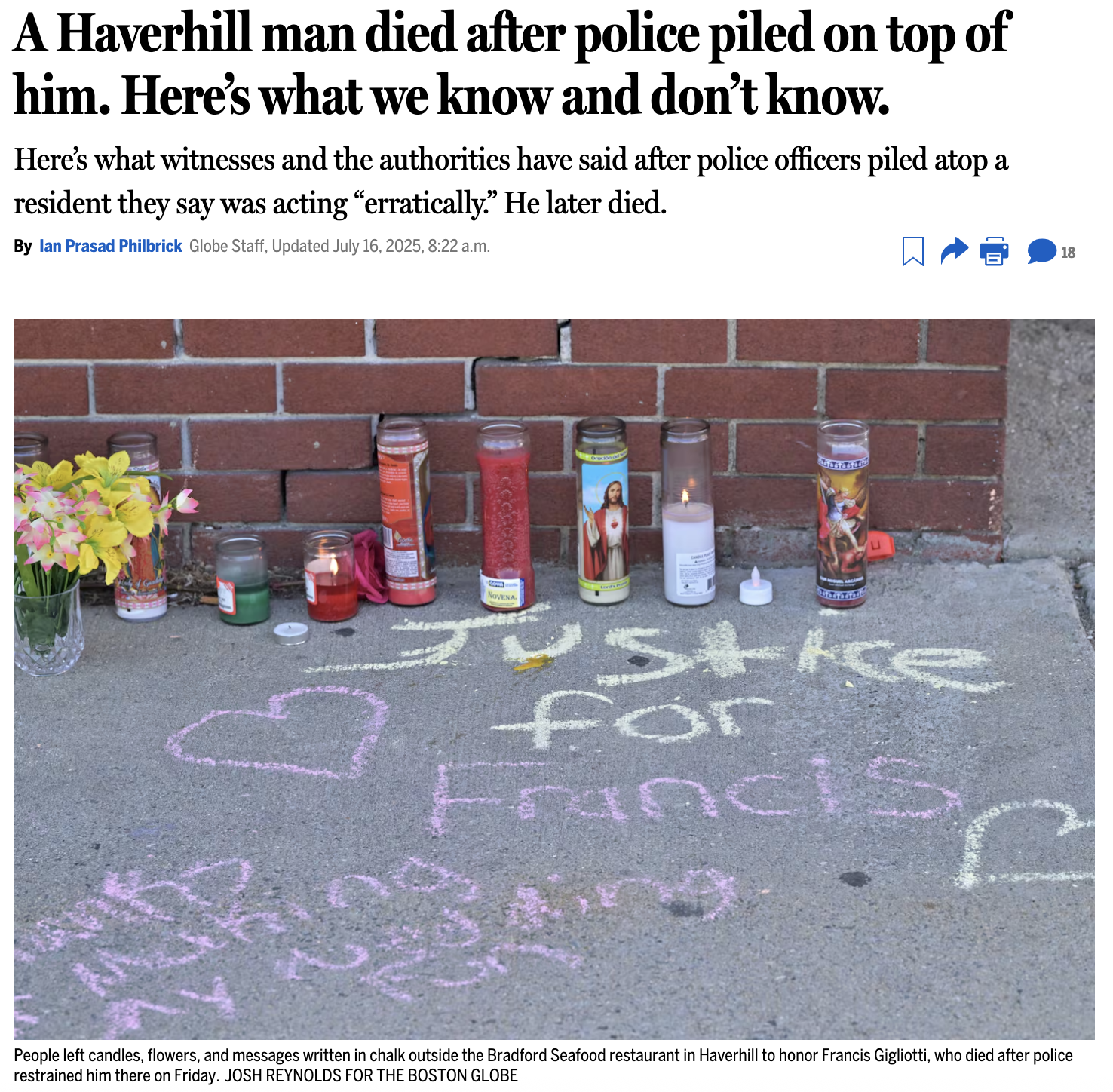
Don’t overuse “breaking news” label
Research shows many people are tuning the news out because it feels overwhelming and anxiety-inducing. As journalists, our job isn’t to protect people from stressful news. Of course we sometimes have to cover things that are stressful and depressing. But we should consider how we’re presenting the news and examine if we’re adding to the sense of overwhelm.
One way we can be mindful about this is by not overusing “breaking news” labels. Many news outlets use the “breaking news” label for news that isn’t actually breaking news. (We wrote about how this happened during the last presidential debate. Is a planned debate really breaking news?)
Of course, there are many times when sending breaking news alerts is absolutely appropriate. But when doing so, be mindful that it’s alerting people to urgent, important information, not just playing into possible hype and anxiety.
In a world where people are already overwhelmed, we have an opportunity to help them navigate through it by being thoughtful about how and when we share information. (More on that here.)
Another quick idea: When a big breaking news situation IS happening, be sure to pause other unrelated alerts. It can feel disconnected and inappropriate when you receive a marketing or lifestyle email while a breaking news situation is unfolding.
Quickly address misinformation
During most major breaking news situations, it usually doesn’t take long for the online rumor mill to start. These situations are often confusing, chaotic and fearful — a perfect atmosphere for misinformation to spread.
When rumors arise, especially in conversation spaces you own (such as your comment section), it often does more harm to not acknowledge them. Instead, we encourage you to address it and quickly set the record straight.
We’ve shared this example from reporter Vic Micolucci of WJXT in Jacksonville before, and we continue to really appreciate how he directly addressed rumors swirling online that journalists had altered photos of Florida beaches reopening during the coronavirus pandemic.
It’s perhaps most important to address misinformation and rumors when they are active and spreading. But we also encourage you to talk to your audience about your approach to handling misinformation more generally. Talk about how you don’t tolerate or spread misinformation. Be honest that it’s an issue for you too, and how it impacts your credibility and your reporting.
When to address misinformation
Research shows that as much as journalists think misinformation is a problem, they rarely address it in their reporting.
There are, of course, legitimate arguments for not covering certain rumors. There may be times when discussing misinformation might bring more unwarranted attention to unverified claims.
So, when should journalists address misinformation? We want to point you this helpful list from First Draft. You can use these questions to help do a quick assessment when deciding when to cover rumors.
- How much engagement has the rumor received, and how do these numbers compare to similar content on the platform?
- Is the discussion around the rumor limited to one online community?
- Has the rumor jumped platforms?
- Did an influencer or verified account share the rumor?
- Have large media outlets covered it rumor?
If you believe the misinformation has gained enough traction to warrant a response, we have more ideas here for how you can address it head-on.
Explain your visuals
Journalists have to make a lot of decisions when it comes to deciding which visuals will help tell the full story. These decisions can be especially important to talk about with our audience during breaking news situations, where the decisions often come with important ethical considerations.
Here are a few practices worth explaining to your audience.
- Explain how you edit photos/videos: If you’re facing criticism that you manipulated visuals you shared, explain what your policy is for altering or editing photos or videos. Even better would be to link to a public-facing policy.
- Get clear about where photos and videos come from. If you’re running an archive photo with a breaking news story, make that abundantly clear in the caption, on screen and any other platforms.
- Talk about how people end up in your photos and videos. Get clear about what your approach is to obtaining visuals from situations like a protest or a crime scene on public property. While it may be legal for us to take an individual’s photo or show them in our live feed, we may sometimes decide not to, due to our ethics.
- If you use graphic visuals, explain why. Share the process of how you decide whether or not to air graphic content. Share how you weigh the responsibility to accurately and compellingly reflect a harsh reality while also avoiding exploitation and respecting the preferences and privacy of both audience members and the subjects of the images.
Check out this post for more strategies for how you can build trust with your visual content in this post.
Explain how you cover big news
When faced with a big story, journalists know how to mobilize. We quickly identify angles, often playing the role of reporter, photographer, editor and social media manager all at the same time. Whether you’re solo or work in a newsroom, covering breaking news well takes a huge investment.
But most people don’t understand what an investment that is, or understand how your staff is working to cover every angle of the story. What if offering a window into the complexity of your work could help lend credibility and inspire an appreciation for the efforts?
When you or your newsroom is putting extra effort into specific coverage, think about how you could shine a light on that investment. How can you explain the components of your coverage? Can you share a list of staff and where they are mobilized across the city? Or can you list the questions you’re trying to answer?
Of course, the goal here isn’t to get a pat on the back. The tone should be focused on showing your commitment to your community and all the ways you’re working on behalf of them — not bragging about how great you are, or how hard you’re working.
Here’s a simple example of how KPCC did this. During live coverage of a school shooting, the team kept a story page updated with dispatches from reporters. At the end of the story file, they offered a window into their staff members’ activities.
Get clear about coverage area/priorities
Even if your coverage area is small, there’s typically a lot of breaking news you could cover. And realistically, you or your newsroom won’t be able to cover it all.
So instead of leaving people to wonder (and make negative assumptions) about why you might have covered that one incident but not that other one, share ahead of time what people can expect from you when it comes to breaking news coverage. Will you cover every road closure? Every school threat? Every fire? Every homicide?
The same goes for staffing as well. Will you have 24/hour coverage, or do you leave overnight coverage to other news outlets?
Whatever the answer might be for you, don’t let people assume it’s because you don’t care or are doing lazy reporting. Instead, bring people along in your process, even if that means explaining that there were last-minute staffing changes, or maybe a situation didn’t turn out how you thought it would. Those are all normal, human things that happen — and acknowledging them is a good first step for building transparency and establishing credibility with your audience.
Another idea: Share links to responsible sources of information for things you don’t cover. If you don’t cover traffic accidents, where would *you* look if you wanted an update?
Show you're part of the community
If you’re a local journalist, sometimes it can be tricky to navigate when a breaking news story in your community becomes national news. You may feel frustrated by journalists who are parachuting in and who may not understand the nuances of your community and what’s really going on.
So if you’re facing an influx of attention and journalists from outside areas, use it as an opportunity to remind people how you or your newsroom are rooted in the local community. Emphasize the depth of your coverage and your deep knowledge of the community. Explain how you or your staff live and work there and how you’re also impacted by what happens. Point to how you’ve been consistenly covering local issues for years.
Here’s an example of what this can look like from Florida station WMBB. When outside news outlets were getting it wrong, the station wasn’t afriad to speak up and say so. With this one-minute video, the journalists established themselves as being a part of and on the side of their local community. As locals, they expressed how they were annoyed and insulted that their experience was being overlooked.
Be a community resource
During difficult breaking news situations — such as a shooting or major disaster — it’s important your audience knows you’re a community resource. Part of being a community resource is being open to listening, answering questions and connecting people to valuable resources and perspectives, even if they come from outside of your newsroom.
Here are a few ways you can do that:
- Link or collaborate with trusted messengers in your community. If a content creator or a local leader has coverage, or a perspective or lens, that adds to community knowledge, consider linking out to their content or sharing it directly with your own audience. Even better, start building these relationships now so you can lean on one another when a crisis arises. We’ve written more about how you can do that here, which builds upon work from the American Press Institute.
- Ask for questions and input. Make it a habit to ask people what questions they have and gather their input into your coverage (ideas on how to do that here). Check in with your audience. Ask them how they’re doing, what they’re curious or worried about, and what things need more clarification. Then listen and respond with empathy.
- Tap your audience for help. Ask them what they’re seeing and hearing. As journalists, we want to show up with answers, but it’s OK to ask your community for help. It improves coverage to be able to reflect community experiences, and doing so is an opportunity to be humble in acknowledging that we can’t be everywhere or have all the answers ourselves. Plus, it’s a great opportunity to show that you value their perspectives.
Where should these explainers go?
We encourage journalists to add transparency directly into coverage rather than only let it live on a policy page that most people won’t see. This is especially important with breaking news, where you’ll have lots of new people tuning into your coverage, many of whom won’t necessarily know your brand or care to research your credibility.
Inserting transparency into coverage could mean adding any of the explainers we talked about in the section above on-air, in a social post, video, newsletter, the top of a story — even in a headline. (For more on what this can look like check out our Transparency and Building Trust On Air Trust Kits.)
The general rule of thumb is that anywhere people are finding your breaking news coverage, they should also be seeing explainers about how you’re working to be fair and accurate with that coverage.
Check out the examples at the bottom of this Trust Kit for more ideas of what this can look like.

Covering breaking news live

Tips for specific breaking news situations
How you handle covering breaking news changes depending on the situation. Some events feel more clear cut, while others require much more care and nuance throughout the coverage process.
As journalists, getting transparent about how you’re working to be fair and factual is always important, but it’s especially important when covering topics that elicit a lot of emotion, involve vulnerable communities or invite heightened public scrutiny.
Below we’re sharing some specific guidance for covering breaking news topics that may come up for journalists.
Protests
Covering protests isn’t easy for journalists. Not only are some journalists putting themselves in harms way, they also can face a lot of pushback from the public. Even if you try to be nuanced and accurate, it’s almost guaranteed that some people will disagree with your reporting. And plenty will see the headline, make a judgment that the story is biased and skip it altogether.
Whether you’re providing local coverage, sharing wire coverage from other outlets, or a mixture of both, it’s important to explain what sets your coverage apart.
In this post, we share more strategies and tips for how newsrooms can work to show what makes their protest coverage trustworthy and credible.
Mass shootings
The news is tragic, and it’s unfolding in an all-too-familiar way. Innocent people have died. Society tries to make sense of the shooter’s motivation and mindset. People and organizations express outrage and sympathy. Paths forward are offered as if they’re simple solutions. Actual change and progress feel incremental or nonexistent.
And journalists try to document and make sense of it all on behalf of their communities — all while trying to leave room to process it as human beings.
Our focus at Trusting News is on supporting journalists as they work to explain their coverage to their audiences. How can they make their mission clear? How can they acknowledge the failings of the media in general while defending their own work? What do they wish their community knew about their integrity?
Remember, every decision you make or ethical framework you rely on is invisible to your audience unless you draw their attention to it. While we hope this never happens in your community, these situations are extremely difficult and ripe for misinformation, making it all the more important for journalists to get really clear about how you approach your work with integrity and on behalf of the community.
This post has a list of resources to help journalists as they cover mass shootings.
Weather/natural disasters
See how other newsrooms do it
Here are some examples of how newsrooms are building trust with their breaking news coverage. For more newsroom examples, check our our newsroom example database.
We’re here to help
We know taking the steps to earn trust isn’t always simple or easy. It takes time and often requires a shift in newsroom routines or workflows.
Any progress you make on implementing strategies in this Trust Kit should be celebrated as a win!
If you find yourself getting stuck, need help brainstorming, or completed the work in a Trust Kit and would like our team to review and give additional advice, reach out to us at info@trustingnews.org or send us a message on LinkedIn.
This Trust Kit was last updated Sept. 5, 2025.
